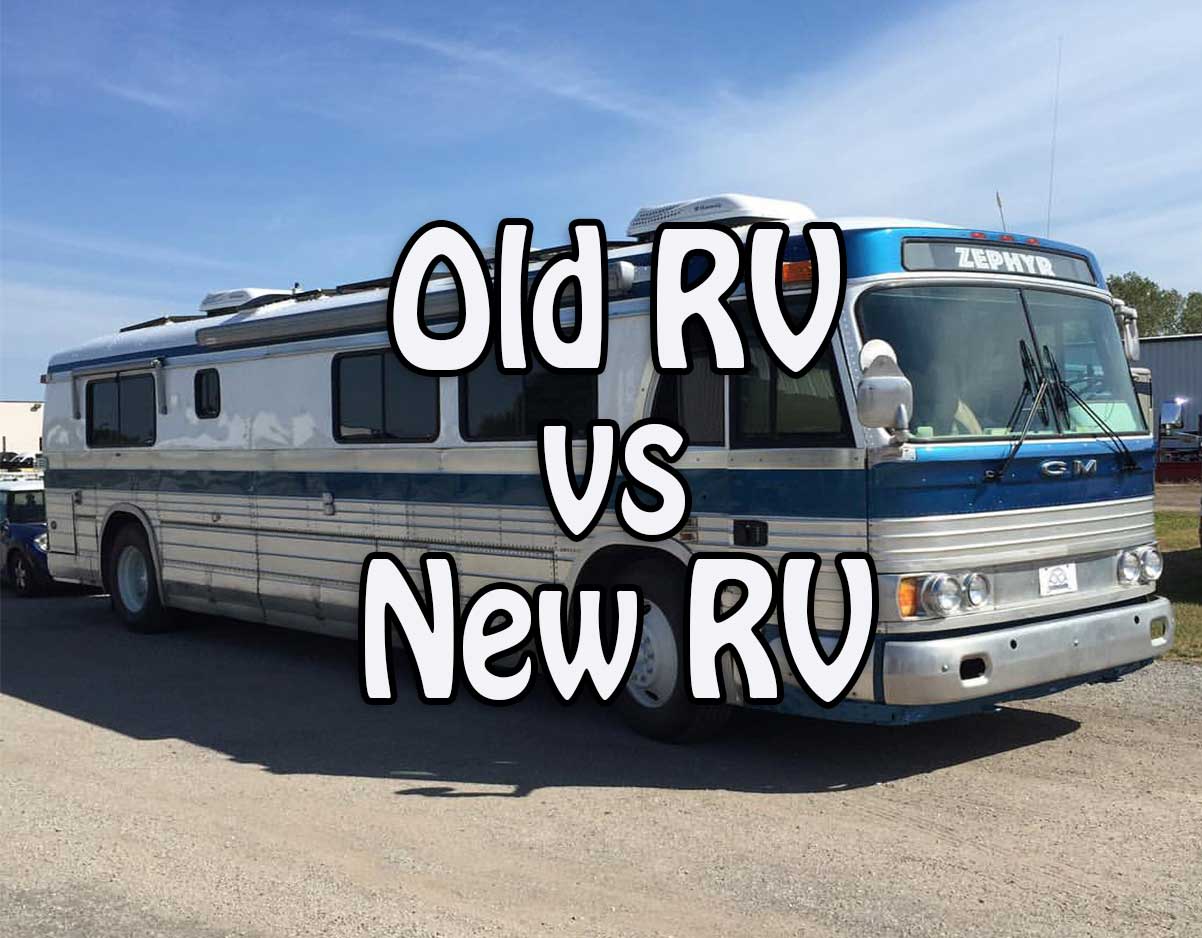
Some of the most frequent questions we’ve gotten over the years (particularly during our summer 2015 bus renovation) have been around the amount we have invested in our RV, and more particularly – why didn’t we just go buy a newer RV with all the features we wanted, rather than building them in ourselves?
Is it really worth the effort the renovate an older RV?
Of course, the ultimate answer comes down to personal preference and style. Not all decisions are purely about what is most cost effective.
In our case however, we truly believe we’ve made the best decisions for both our desires AND budget.
Earlier this week, we hosted a live video cast on this exact topic, and below is the archive of it if you’d prefer to hear us babble on about it. Below is also a pretty thorough text summary of what we talked about if video isn’t your thing today.
First… A Little History
For those newer to our story, it might be important to catch you up on how a vintage bus came into our lives to begin with.
We started our full timing adventures in super small travel trailers — first a 16″² T@B teardrop, then a 17″² Oliver Travel Trailer fiberglass egg.
After 4 years traveling ultra small, we were ready for a little more space as we slowed down our pace. Not wanting to tow something that would require a large truck as a daily driver, we started our search looking for relatively small modern Class-A motorhomes (in the 26-30″² range).
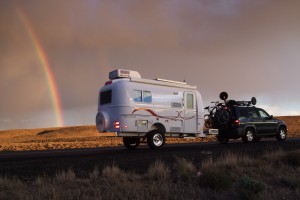
We set a first year acquisition goal of spending around $60 – $70k cash for our next home – which was roughly equivalent to what we sold our truck and trailer for.
But we quickly found that the quality we desired was just not readily available new (or even slightly used) in our price range.
Moving into a quality motorhome would require us to at least double our budget – and that would still only get us an entry level coach, and would leave us with a generic ‘traditional’ looking RV that we’d want to pimp out anyway.
We honestly didn’t go much further down that path, because in the meantime we had gotten turned on to vintage bus conversions by some fellow nomadic friends (Ben & Karen of Creative Cruiser and Sean & Louise of Our Odyssey).
By going for a bus conversion – we could get a high quality bus chassis (which some very high end motorhome are actually built on), something a LOT more unique, and we discovered that older buses could often be purchased for a song.
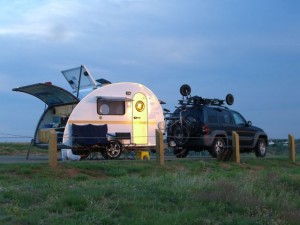
We didn’t want a 45′ long monster with tag axels though – but since most buses are built as large as is legal to maximize passenger capacity, that drove us to look to the past when smaller sizes were common.
Buses from the 60s in particular were 35″² long – a perfect size for still getting into many state and national park campgrounds. And vintage buses look super cool and unique too.
We did extensive research on bus conversions starting during the spring of 2011, and we bought an Amtrak Rail Pass to travel the country to look at buses and learn from other busnuts’.
During our search, we quickly fell in love with the history and classic styling of buses from this era.
We found our bus on Craigslist and we purchased Zephyr for $8000. Despite being the cheapest of all the buses we had looked at, she was livable from day one, and would be something we could renovate and modernize as we went.
We knew she should need a bunch of immediate attention to bring her up to date on 15 years of neglected maintenance. But even so, we’d be left with a pretty sizable budget to make her truly our own, and our first year costs were below our target.
Buses, especially vintage buses, are not for everyone. But for us, it has proven to be a rewarding adventure.
What Has It Cost To Renovate So Far?
We’ve done several rounds of updating — sometimes completely on our own, sometimes with the help of friends, sometimes by hiring out contractors in our travels, and sometimes in shops for extended renovations.
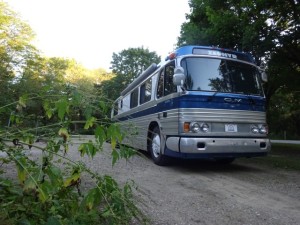
All and all, with adding lithium batteries, solar, updating the interior, updating all of the appliances, and even our most recent round of major renovations (all plumbing re-done, new exterior paint, hydronic heating, dual pane windows, new awnings, new generator and bunches of other upgrades) – we’ve spent a total of around $120k.
That doesn’t include general maintenance costs to keep Zephyr on the road over the years – any motorhome is going to have those sorts of expenses. But it does include the major mechanical work we needed to get Zephyr initially road worthy – these expenses we considered part of the acquisition cost (including the engine rebuild of 2013, new tires & wheels and replacing all the air suspension bags).
This cost has been spread out over 4 years. That not only makes it easier on our budget – we can save up for big projects and approach them as we’re ready for them. But it’s also made it easier for our time planning. Other friends approaching big conversion projects have had their coaches in the shop for years trying to do everything at once.
By not tackling everything at once, we’ve been able to carefully consider the upgrades we want after actual time on the road. We’ve gotten to enjoy our coach, life on the road, and learn what upgrades we really desired.
What kind of Motorhome would $120k Buy?
Zephyr used to be a highway bus, hauling 41 passengers and their luggage around the desert southwest from 1961-1985. She’s overbuilt, with proven solid bones, and copious amount of excess cargo capacity. She has solid wood cabinetry, 1.5″ of foam insulation all the way around, huge holding tanks, and a layout that is perfect for us.
Zephyr is not at all like most modern RVs.
If we wanted to buy a newer modern Class-A motorhome that had a similar quality build that could withstand full-timing for 10+ years, we’d need to be looking at a $250-$500k coach. We probably would not be able to find anything of such high quality lacking slides (a plus in our book), or under 35-40′ long.
And no new coach would come with the amount of solar we consider a bare minimum, or lithium batteries, or desk space suitable for two tech workers.
In other words – even if we bought the highest end new coach out there, we’d still immediately need to invest in substantial upgrades and renovations for the things that we personally consider essential. Or we’d be looking at completely custom build such as Marathon Coach, which start at a million buckaroos (on a 45′ chassis),
And, even after all that, it would still look like just about any other motorhome on the road.
We’ve been in many newer coaches that sell in the $100-$150k range (comparable to what we’ve invested into our coach) – and while there are some nifty options out there, at that price range they all feel like a step down in quality. Thinner walls, less insulations, maxed out cargo capacity, limited holding tank capacity, and lighter weight cabinetry & fixtures that don’t feel fated to hold up for the long haul.
-
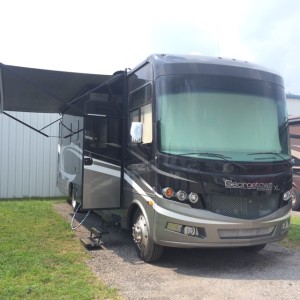
The 2014 Forest River Georgetown we borrowed As an example – while living onsite in Elkhart overseeing our latest round of renovations, we had the opportunity to stay in a 2014 Forest River Georgetown XL 377 (click for our video walk-thru from a full timer’s perspective). It’s a 38′ gas powered Class-A motorhome with 3 slides. We looked up comparable sales on RVTrader.com – and this coach is listing used with a similar age & condition for about $110-$140k. While it was great to have the crash space in a swanking feeling mobile condo (and we were super thankful for it!), the Georgetown XL was already showing signs of serious wear & tear after under a year of use.
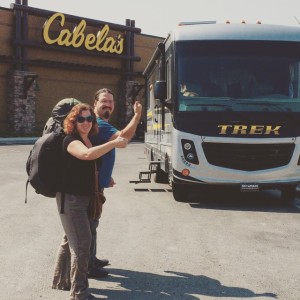
- We know that the Snowmad’s Trek motorhome they just road tested for 6-months lists new in the low $100s. We had opportunity to stay a couple nights & ride as guests while we were up in Alaska, and while it’s got some nice features – in terms of quality, its definitely more suitable for part time RVing adventures.
- Our friends the Wynns are currently testing out a brand new Fleetwood Bounder on a gas chassis, which retails in the higher $100s. In their most recent post, they said they consider an entry level diesel pusher to be priced $150+.
Of course, many brand new coaches have a high sticker price which generally sell 20-30% lower in actuality. Obviously, if we *wanted* to go the newer Class-A route and stay in the low 100s, we’d seek out getting the most bang for our buck and probably end up with something fairly nice.
But the point is, for what we’ve spent on Zephyr – a modern feature packed vintage classic with solid bones that has already withstood 50+ years on the road (and hopefully many more to come) – we would only be able to afford a ‘recreational’ class gas powered motorhome, or perhaps a discounted entry level diesel pusher.
And neither would be close to what we’d personally desire.
Advantages of New(er)
Of course, there’s nothing inherently wrong with going with a newer coach. There are some definite benefits.
- It’s.. well. New. It’ll have very little, if any, wear and tear on it. You’ll be the first to break it in – to put the first scratches on it. No one else will slept in your bed. Your poop will be the first to hit the holding tank. Some folk just like new.
- It’ll come with a warranty from the manufacturer. This can be both a blessing and a curse. If the company is good about warranty repairs (like our Oliver was) – it’s a blessing. The problems you have during that time period will be covered, and hopefully easy to navigate. However, a manufacturer’s warranty may come with gotchas (like our T@b did) – such as needing to be serviced only at the dealer you bought from, or maybe at widely scattered “authorized service centers”. These locations may not be convenient to where you discovered the problem, or the places you want to go. You may also encounter difficulty getting an appointment that doesn’t require you substantially interrupting your travels.
- Latest and greatest. Hopefully, most newer coaches will come installed with the latest in technology for appliances and systems integration.
Of course, there are plenty of downsides.
Unless you find a bargain on a newer coach (and they are out there – especially as dealers are ready to clear out last year’s inventory), it’s going to cost more than going used. And not just in the purchase price, but also the insurance costs to cover that increased value. And because you’ve paid for a shiny new coach, if you desire customizations you may be more reluctant to do them.
Customizing a new stock RV may actually decrease it’s resale value – unless you find a niche buyer who wants exactly what you did to it.
Does Wisdom Come with Age?
Now, the great thing about these motorhomes that are priced in the higher range ($300k plus), is they tend to be able to withstand the test of time better than their lower end cousins.
After any motorhome is over 10 or so years old, they lose a good bit of their value (the first big hit being off course the moment they drive of the lot).
The reasons are simple – they’re harder to get financing on, they’re harder to get extended warranties on and folks who can afford coaches of this caliber tend to want new and shiny. And, while their chassis & engines components may have many miles left in them – they are likely in need of some interior refreshing, new paint and appliance replacement soon.
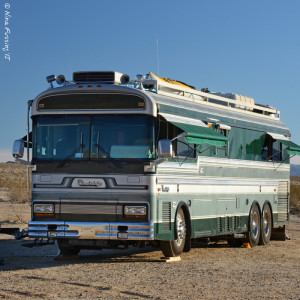
There’s just simply less market for older coaches, and less buyers with cash in hand to take them over.
As a result, motorhomes that once sold for over a $300k (which would be over a 1/2 mill PLUS in today’s economy), can be bought in the 20-30 year range for a tenth the price.
We have friends who have high end mid-80s Newells and Wanderlodges that they bought in the $30-50k range that look absolutely stunningly beautiful and have served them well for years.
Shopping for older high end gems can be a great way to go if you want a solid foundation to customize a mobile home to your exact desires.
Other brands we consider worthwhile researching further are Newmar, Prevost (they build the chassis – several companies made conversions on them), Country Coach, Monaco and Foretravel. That list certainly isn’t complete, and nor is there a guarantee that if you buy one of these brands that you’ve got a safe bet.
And of course, there’s going for a true bus conversion (one that was formally a passenger coach) like we did built on GMs, MCIs, Flxible, Eagles and Prevosts. If that’s your desire, get involved with communities like Bus Conversion Magazine (subscribe to their excellent magazine!) and Bus Nut to research further.
There’s also an entire community around converting old school buses, which is an option as well.
But there are risks and challenges of course.
- There are campgrounds that have strict 10 year rules, and some even specifically restrict bus or school bus conversions. Some exempt the rule for well maintained units. We’ve personally never been turned away, ours tends to be seen as a classic, not old (and with all our renovations, we can argue we’re a new RV at this point.) But we also tend to prefer public camping options, where such rules don’t apply.
- Getting insurance, warranties and even work done on older coaches can be a bit tougher too.
- Finding a full timer’s full coverage insurance policy on a converted bus was a challenge, but our agent (Gina Shaver of Epic-Ins) was able to find us a suitable option. We’ll be getting an appraisal done on the bus with all the upgrades, and be pushing for an ‘agreed value’ policy to cover our expenditures.
- And you will need to be diligent about preventative maintenance – high end coaches tend to be built on diesel engines, which are pretty tough beasts. But they need maintenance that is costlier than maintaining a gas engine. Keep in mind, especially former service coaches – were designed to kept in service by an income generating business. Not an individual.
- If you go with an old 2-stroke diesel engine like ours is, the number of mechanics able and willing to work on them is dwindling by the day. We’ve soaked up every opportunity we can to learn more about maintaining our engine on our own.
With any RV purchase, you also shouldn’t look at any money you put into them as an investment into the value of the coach.
- Buying new, you’ll almost always experience depreciation as soon as you drive off the lot.
- If you buy a coach a few years old, more than likely you’ll have much less depreciation until it reaches about 10 years old.
- Buying really old, you’ll likely be able to resell at close to what you paid upfront.
But any money you put into the coach in upgrade/mainenance is unlikely to increase the resale value of the coach by much. At the end of the day, unless you’ve really put together a restored gem – a 30 year old motorhome is a 30 year and 1 day old motorhome.
And that motorhome is only going to be worth what someone is willing to pay for it.
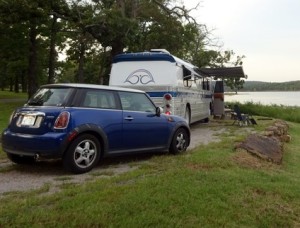
For us, we feel we’ve put into our coach what we we’re willing to afford for the quality of life the upgrades will give us for years to come as Zephyr serves as our mobile home base.
Many of the updates we’ve done (engine rebuild, repainting, appliance replacements) are more on par to putting a new roof on a house. A new roof doesn’t necessarily increase the value of the home by much, but rather protects the value of the home and maybe makes your home a bit more attractive to a buyer than the house down the street.
Do we hope that we’ll be able to sell for more than the original $8000 purchase price? Of course… we do believe we have added a decent amount of real value to Zephyr from the day we found her. But will we ever get even close to $120k back should we ever sell? Nope.
But we weren’t building to sell. We were building to support our desired lifestyle. We don’t see life without RVing in our foreseeable future.
If you decide to go older high end coach, just go in eyes wide open. Anticipate needed immediate repairs and updates, and ongoing maintenance. Don’t budget just the purchase price of the coach, be prepared with an ample cushion.

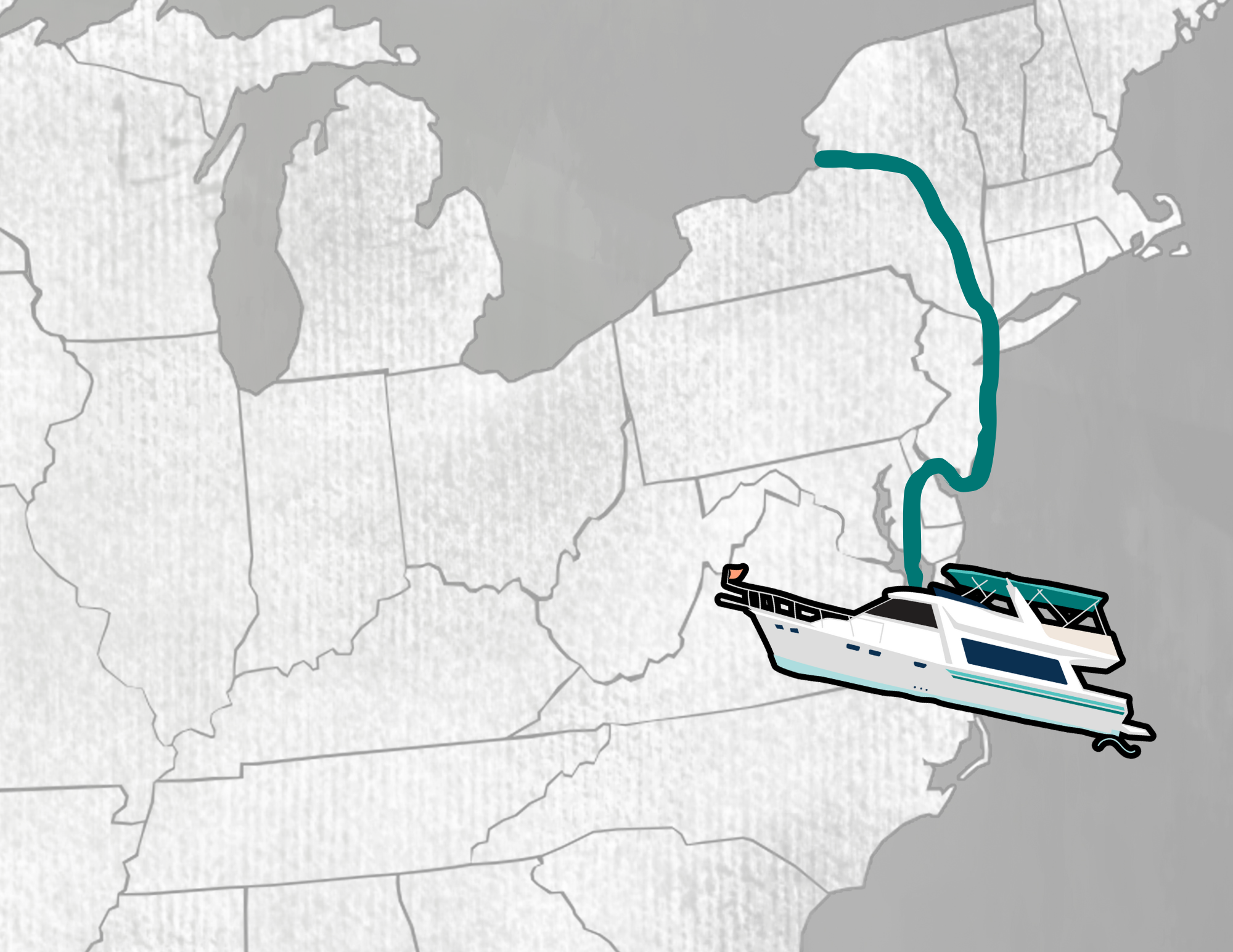
Fantastic read. Well written, I love this blog. I had no idea I had an Orphan though until I read this post about them. Good to know.
In terms of insurance we have an AV policy with progressive took over a month to write, it runs us 2K year give or take including FT Coverage, we do all our repairs and mods ourselves save for getting new tires on. We have a 2004 Fleetwood Wilderness 365FLTS. It is amazing, super high quality much better than our previous 2 rigs(78 Prowler and 77 KIT Kamper) . All we had to do with this one was add on and mod to our desire, we didnt have to fix leaks, ect..it was a real change from the previous 2 vacation rigs we had.
Our rig is better than any rental we ever had in the past(we rented middle income places before going FT in 2012 and they all had issues with heat cooling the range ect..didnt matter)
We got rid of the atwood range and modded in a Dickenson 3 Burner Mediter range.
We got rid of the LP fridge and installed a 5.8CF vert residential Freezer, and moved our fridge needs to a Vertical Whynter 3.6CF fridge/freezer 110/12/24V that is freestanding.
We pulled the abs/fiberglass kitchen sink and installed a 10″ deep X 20″ W Ariel Hand welded single basin stainless sink. Add in a new stainless faucet that we bought used on ebay came from a lab in a university, they were updating and selling off their old stuff . Hard to find 4″ center quality faucet.
We gutted the front living room and remodeled that into a 2nd bedroom complete with residential custom made mattress and privacy door.
We relocated the 1 battery from its compartment and remodeled the batt compartment into housing for a water softener setup.
We Pulled the crap Dometic and installed an Atwood Air Command 15K w/heat pump. We installed a second 13K ac in the front. same Air Command- no heat pump.
Put in a new water heater , new furnace, got 2 new trojan AGM cell batts, new batts boxes, porc toilet, Pulled the OEM Hood Vent and replaced with a rectangular Mobile Home version that is non obtrusive.
We are getting ready to mod the back bedroom as we speak, we are drawing up plans to convert to murphy bed so I can exercise daily with my fold up bike. Also, we have plans to install a dickenson Marine LP Fireplace as well.
I think if you are an rvr you should be DIY on a very basic level or your experience will be far different than that of a DIYer in rv life.
Cheers thanks for a super great peice.
C&C — 1st time reader. Kewel stuff. On boat, have you done a segment on “boat jokes?” Like in, the scene from “Caddyshack?” Boats are so complex, they are the stuff of comedy.
Wish you the best.
So true. We bought a 1990 Foretravel that we love. It had been well maintained and we have driven it all over the southern US without any trouble, I love the cherry walls and cabinets. I am particularly pleased with the power our motorhome has tackleing the mountain passes. We have taken her over a 9% grade with no trouble. And the best thing about her – we paid $13,500!! Everything works. Of course we have a list of upgrades such as some serious solar for camping off the grid, but none are urgent. We have been living in it full time and plan to continue doing so indefinitely. Very happy with the quality and our freedom.
Hi, I have a 1990 Foretravel also. Been fixing it up for a couple of years and looks very nice. Good to hear there are other full timers like me. Happy new year!
I know you suggested a few brands, but what should we be looking for in terms of longevity if we go off that list? What we’re currently looking at for full-timing is a Damon Outlaw, and their oldest model is only 2007 so we don’t get to see how well it ages. Any tips and tricks for seeing if something looks like it will be stable?
Oh gosh.. that’s a topic worthy of it’s own post (heck, maybe even a book), and not one we really have the expertise to provide.
But recommend joining some of the many RVing groups out there to continue your research on specific brands, and the common things that come up. Believe there may even be books out there on shopping for used RVs and what to look for.
We just simply went an entirely different route than shopping standard RVs when we went vintage bus conversion.
I understand. I love the floorplan the outlaw provides, but it’s a little (okay a lot) nerve-wracking not knowing how it’ll stand up to the test of time!If our jobs didn’t require the space we’d probably go for a bus conversion too!
Please, please please, don’t judge a TREK by the piece of (ahem) you looked at. We have had Safari built Trek’s since 1995. With 28′ of total living space (bed rolls out of living room ceiling) and now 24′ of same.
Boondocked for long stretches of time on house solar and because our length is manageable we’ve been way back in BLM and Forest Service areas with only trucks with campers – the big guys can’t get in there.
The Trek’s built by Monaco steadily deteriorated in quality.
The 2016 rendition by some alphabet company that is just sickening.
With Fleetwood buying the name recently, we hope for a reprise of the old style, super quality Trek.
At a recent rally, an RVIA insider told me that in todays dollars, it would cost around $200k to build our little Trek. Which proves, “Older is Wiser” to do the work to upgrade engine and solar, maybe floors and some front end work, you end up with a super-Class A.
Indeed.. the Safari Treks are classics, and well built.
I read the comment about Chris & Cherie getting deals that ordinary folks who aren’t well known bloggers with amazement. This simply is not true. I can and have found somewhat better deals on much they have had done and I don’t have any blog at all, much less a well known one. What is true, as Chris & Cherie experienced is that going off can lead to inaction and sometimes mistakes. The exact same thing happens to stix & brix homeowners, so it’s not an RV specific thing. — edward
There are some things we get ‘deals’ on, and other things we don’t. It’s not a goal of ours however to use our blogging credibility to get deals. We get what we want, and always budget fair market value for it. If someone offers us a no-strings-attached deal, we might consider it. But our ultimate goal is designing our systems how we want them.
Great article! We (Lizzie and Barb) have been having work done on our newly purchased 1997 Safari Trek 2430. We’ve been renovating and upgrading since we found her – older Treks are rare! We full timed from 1995 to 2000 in a new Safari Trek 2830 – and the fella who bought her is downsizing today to use her more.
These are the comments we get from: the Truck Center (ignition module), the shocks shop (bags), the front end shop (rocker arm) and finally the RV Techs (jack computer)… to paraphrase a tiny bit: This RV is how old? I would never have guessed. It’s in amazing shape and the materials they used are not usually seen in this small a rig. Then to quote “This is a really nice RV.” “Gee, you loose 6-8 feet in length right off the bat by having that [full sized queen] bed up in the ceiling.” “Cool, great design.”
Interesting comments from the same folks: “I have (points to a 2005) this thing, it’s been here for years. It started falling apart right away and the owners decided it’s not worth fixing.” “See that 2010 over there? That one’s owner decided it wasn’t worth fixing, so here it sits. I can’t sell the thing” “Wow, we get RVs in here that are only 5 or six years old and your 18 old rig just kills them!” The above were all big name RV’s and they were not the little junky ones the big guys build to get the customer into the lifestyle.
Renovate. Choose wisely. Choose wisely (hear that?). Live above your means by renovating a top quality bus or RV.
Full-time life was amazing in our little 28′. We lived in BLM, Forest Service & National Parks – Mexico to Labrador. We WorkCamped all over the place. One of our long trips was from CA to FL (where we met some RV Women to caravan with) to Labrador (that’s the end of the north road, folks). Amazing trip – our RV fit right into the ferry going to Newfoundland and we took our toads to Labrador. We stayed in a B&B with the most dreamy Cod dinners and home baked bread – the jams this gal made from far north dew berries were stellar (another story).
You don’t need much space really, especially if your life is lived outdoors and when indoors you are writing of the grand adventure.
BTW – we are and were back then gourmet cooks, focused on a low impact organic foods lifestyle mostly outdoors birding, kayaking, hiking, meditating, exploring history. And we are almost ready to do it again!
Thank you Technomadia and The Wynns for some good info on staying connected and blogging.
Renovate. Choose wisely. You can have a tiny impact and live luxuriously, lovingly and long.
Lizzie
In our situation, a bus conversion wouldn’t be practical–full-timing is not something that we could get into, and we can barely get our 30 foot Class-C 2001 Lazy Daze into our driveway. We bought it used from an owner who added solar panels and various other goodies and have had it for over 8 years. We haven’t gone on any major trips for a while (long story) and I wonder if some of the more “exclusive” parks will reject it for being over ten years old. But Lazy Dazes are a cut or two above ordinary Class C units and tend to stay good looking for a long time. Something you can relate to is that the folks who run Lazy Daze don’t believe in slide-outs. Or as I put it: Slides are good for playgrounds and guitar players; not so good for RVs.
I love this post and you are so on point. We have LOVED our 1986 Wanderlodge. The quality is unparalleled and its character is something I truly love. We are sad to sell it, but new adventures call and another rig is in our future!!!
I know your post is from 2015 and that some time ago. I have always loved those off the hook Bird Wonderlodges. No motorhome is over built like they are. But wondering if I were to dive in an buy one are parts and service almost nonexistent?
This is what I’ve heard. Is it so?
Having never owned a Bluebird, would be impossible for us to answer. Would recommend finding some of the Bluebird user groups out there.
Good points, all! For $120k, you would have “only” been able to afford a moderately used diesel pusher that would still have needed tens of thousands of dollars of mods to make livable for a full timer (LFP batteries and solar for one thing.) The only way to beat what you’ve done would have been to find a full timer with a upgraded and well cared for vintage unit and who was getting out of RV’ing. Wandertopia’s unit comes to mind…
I am an avid backpacker preparing to acquire a class A coach as a boondocking basecamp in the western US and Canada. You have convinced me to by a used Class A coach and use the savings to engage a supplier to install solar and related energy management systems, internet, remote tire pressure monitoring, Maxx Fans, composting toilet, etc.
Can you offer referrals to a company that will install all of these upgrades for me? I realize you had difficulties with Master Tech RV. would it be better to use different installers for different systems?
I would be happy to book a paid consult and have done so twice with Jason Wynn.
For solar… check our solar page at http://www.technomadia.co/solar – we have installer recommendations there.
For the other items, we’ve only has experience with Master Tech, or doing it ourselves at this point. Check online reviews of any shop you’re considering, and trust your intuition before contracting any work.
Excellent article !!
The real issue is whether you are getting an RV for weekend/occasional trips or are going to fulltime. I fulltimed in my class C for 4 years and what is very obvious is that the build quality of most RVs that aren’t based on a bus chassis is just not that good. Most RVs are designed for occasional use whereas buses are designed for rugged continuous use. Test drive a bus based RV and then test drive a standard non bus based RV and compare the handling, comfort and road noise. That is why most very high end RVs are based on bus chassis.
For these reasons, when i go back to full timing my rig will be a bus conversion rather than a traditional RV.
Such great points you’ve made here! We’re always asked what our favorite RV is or which one we think is best and our answer is always, “the one we would build from the ground up”. It’s next to impossible to find the perfect full time RV much as it impossible for a manufacture to build one that suits everyone’s needs (although they could do much better). So then you have to either decide to settle with what is on the market floor, buy used and remodel, or build from scratch. To each their own and there is no wrong or right way to go about it. I love your bus, the story it tells and all of the updates have made it just that much more incredible. It sounds like a bargain price to me, I expected it to be much more and agree that finding something similar new would be a huge challenge and cost a bundle more.
What is that black second door behind the left front tire? What is the GVWR? What is the loaded weight?
Are you referring to the ventilated bay? That used to be air conditioning components when it was a passenger bus, then was our generator bay and is now our propane & outdoor stuff bay.
Believe GVWR is in the low 30s, and we weigh in around 24-25k (need to get a new weight after this round of renovations.)
What a great article guys on our wonderful Bus conversions. The one we like is sometimes when we are fueling someone will come up and ask,”who is in side”. We laugh and say” we can’t tell you” They just keeping asking again. Like there is some famous singer, LOL
We have a 1979 MCI 5C Saudi Bus. It cost us $15,000.00 originally in 2010. We did the original conversion changes for 5,000.00 more and went on the road for awhile and little by little put another 15,000 into it. All new appliances, flooring, New large inverter Hybrid that share power if we need it, air ride seats, large tanks were in it when we bought it as well as some cabinets. Being i was a contractor had a lot of leftover material such as tile and cabinets, wiring, switches etc. Point is we did it very inexpensively and have a very livable coach as well as all steel, stainless steel and aluminum. No fiberglass or plastic. They tough and pleasing to the eye. Have never been turned down. Had to send pictures a few times and they say come ahead when they see it.
You guys did great with your and may you have many years on the road.
Dave5Cs
I wonder how many of the new motorhomes are going to still be around in 10-20-30-40-50 years? How many of them will have 2-3 million miles on the body and still be capable of that many more miles? Our 1968 MCI has been great for us, finishing up our 12th year of fulltiming. Our initial cost was 4 times what yours was, the market was higher when we bought it. Did a bunch of upgrades over the years and would have only been into it for half of what you have in yours if we hadn’t had to rebuild the engine last summer. Still only into it for about $100,000 which was well worth it for the freedom it gave us to travel around the U.S. and see and do the things that we have done. We have had a long range plan that looks like it will happen this year or early next year, so we are going to put the bus up for sale when we get back to Yuma in another week or so. Would love to get $35,000-$40,000 for it but realistically it is probably worth $25,000.
We have had a long range plan that looks like it will happen this year or early next year, so we are going to put the bus up for sale when we get back to Yuma in another week or so. Would love to get $35,000-$40,000 for it but realistically it is probably worth $25,000.
Enjoyed watching the talk on this, as well as reading the blog post. DH and I bought a 2003 Newmar Dutch Star 3802 in July 2013 to fulltime in starting mid 2016 when we sell our house. Originally planned to go fulltime last year, but getting DH to quit his job has been harder than I thought it would be.
You talking about not being afraid to make the space your own really has helped me a lot, because I was hesitant about replacing all those hideous accordion shades and painting the interior walls (also hideous), mostly because I was afraid of affecting resale value. Whatever we do, it’s not going to make a big difference in resale value. The list of stuff we need to replace keeps getting longer, but after viewing your chat, I’m comfortable spending the money so we can live the life we want, in a coach that’s comfortable for us. Thanks for all you do in advising us future travelers.
You nailed it Cherie! Your article was perfect for someone trying to decide between brand new, a bus conversion/renovation or perhaps something in-between like a Wanderlodge. As someone who’s doing the later, I advise anyone facing this decision to first evaluate 1) their needs, wants and intended use, and 2) consider their ability/aptitude to do their own minor mechanical work. We all WANT that restored vintage bus tailored to our individual needs like yours, but getting there involves allot more of #2 above than most can possibly imagine (&/or a wide open credit card limit). Congrats to you both!
Well done post as usual. Your timing for beginning your full time life was perfect; Chris doing it himself. meeting Cherie who had a similar wanderlust, stepping up the rigs and being flexible in skill set and character and there you have it!
i think you summed it up well with it really depends on what you want…
The Zephyr looks great. The $120K you’ve spent would have been thousands more for someone else who doesn’t have a popular blog. Regular people don’t get a couch to test out, or weeks of engine work where mechanics come in on weekends to make your time line and let you sleep on premises. They know everything is published and read by their target audience. Same with the latest upgrades. I don’t believe this happens for regular folks. I had a T@b at the same time Chris did, and that’s how I started following you. Always appreciate reading about the innovations and transformations.
Actually, Master Tech lets all of their customers sleep on premise, as does Interstate (where our rebuild was at). And there were other customers who’s projects were behind schedule to who they gave a lot of priority to as well (often times leaving ours with no work being done). Master Tech puts their ‘HOT’ (ie. past due) jobs as the top priority, and we talked and interacted with many in the shop (other customers and employees) that ours was not a ‘special case’ because of the publicity.
Shops know having any customer stuck for extra weeks/months while work was not getting done was not a good situation for anyone.
We also weren’t *looking* to replace the couch, so that’s not an item we would have paid for anyway. We paid full fair market price for our renovations, with only a few ‘gifts’ of items (all clearly disclosed). And hey, that IS a perk for all of the work we do here on the blog.
Running a blog of this size is a LOT of work and expense. This post & video alone took over 20 hours of effort. Not to mention the hosting costs to provide this to our readers.
For the record, we all truly appreciate your and Chris’ time in this blog!
I appreciate this balanced explanation, peppered with plenty of hard earned real life experience. My own experience is that anyone who tells you their RV style is the best, without explaining the tradeoffs, hasn’t been in their RV for very long.
We’re all driving in depreciating vehicles with poor mileage and a to-do list that never seems to end. The guy in the tent wakes up to the same view I see out my RV window. The extra cost just buys some space and comfort along the way.
The best thing about our RV isn’t the electrical upgrades or the MPG or the floorplan. The best thing about our RV is the places it takes us!
well said Joe…